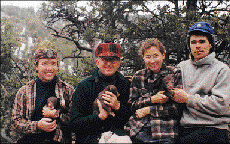
Students and teacher hold up their prizes from a winter outing to study wild bears. From left to right: Dana Schurtleff, Hal Black, April Young, and Wade Paskett.
By Jennifer Browning
Waiting in breathless anticipation for a black bear to make its appearance, a group of BYU students sits hushed in the depths of the woods. For these students, the forest is a research lab.
Luring and trapping black bears has become a classroom adventure for Hal Black, professor of zoology, his graduate students, and about anyone else who wants to come along–from Boy Scout troops to TV news crews.
For the past seven and a half years, Black has been taking groups to the remote Bookcliffs of eastern Utah several times a year to trap bears. Driving four wheelers, the researchers set out early in the morning to check live traps made from 50 gallon drums baited with rotting meat. In the back of the drum is a triggering mechanism smeared with peanut butter and bacon. When caught, the bear will be anesthetized, marked with ear tags, and measured. If the trapped bear is female, a transmitter collar will be placed around her neck. “We catch anywhere from six to 20 new bears a year,” Black says.
The 10 year project is primarily focused on female black bears. “Females are easiest to work with, and they give us the best information on the health of the population,” says Black. “We measure how often they have litters, when they reach reproductive age, and how successful they are at raising their young the first year and a half of life.”
During the winter hibernation months, he and his students rely on the females’ transmitter collars to lead them to dens. “When we come to a den, the bear is awake by the time we get there. They often see us and growl their displeasure. Occasionally they make a bluff charge at the entrance, but we’ve never felt any particular danger,” Black says. “They won’t get up and run away because they aren’t fit for it.”
Within 10 minutes of being anesthetized, the bear is usually asleep. “We can go in and drag them out, change their collar, count the cubs, check the sex of the cubs, and check the general conditions. We’re also interested in what kind of den they are in.”
Besides being an unusual classroom experience, the project has given the Utah Division of Wildlife Resources and the Bureau of Land Management information to determine management strategies. With only two and a half years left on the project funded by these agencies and BYU, Black emphasizes the benefits of an extended project. “With a long-lived study like this, you can establish a study area and get long-term data. We are able to see variation from year to year.”
One of the most interesting behavioral studies has been analyzing bears’ travel patterns. “The bears aren’t just wandering around in circles; they seem to be going someplace,” Black says. “There is some data that their movements are more exaggerated during the summer mating season because they are increasing their likelihood of an encounter.”
Using tracking dogs with a string dispenser to mark their path, the researchers follow the movements of a bear for several miles. “It’s almost as though we are riding on the bear’s back because the dogs can approximate its path through the forest with very little deviation.”
Following the string left by the dogs, researchers retrace their steps to get a precise trail traversed by a bear in woodlands, meadows, and forests. “It gives the Bureau of Land Management a good idea of what habitat the bears are using and why,” Black says.
Black and his students have developed various other studies about unique bear behavior and physiological traits. The extended research topics range from how bears help in plant seed dispersal to the reasons bears lose unusually low amounts of bone and muscle mass during the hibernation months. “Bears are protected from osteoporosis or bone loss during hibernation,” Black says. “Someone is probably going to discover a hormone that is going to make some pharmaceutical company very rich because obviously bears have a trick; we just don’t know what it is.”
Black’s students have also studied bears’ diets. In one case, the group took more than four pounds of insects out of a bear’s stomach–75,000 ants. “This little bear, by 8 p.m. on a summer night, had stuffed himself with miniature ‘turkeys,'” Black chuckles.
While this project has produced several masters’ theses and publications and has drawn public and media attention, Black emphasizes, “It’s been a fun project–a project not for individual glory, but cooperation. When we go out and uncover a den and find the bear and her cubs, it’s just instant satisfaction.”






